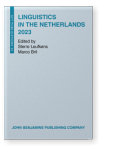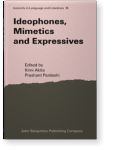Mark Dingemanse
List of John Benjamins publications for which Mark Dingemanse plays a role.
Journal
Titles
Linguistics in the Netherlands 2021
Edited by Mark Dingemanse, Eva van Lier and Jorrig Vogels
[Linguistics in the Netherlands, 38] 2021. iii, 178 pp.
Subjects Theoretical linguistics
Linguistics in the Netherlands 2020
Edited by Elena Tribushinina and Mark Dingemanse
[Linguistics in the Netherlands, 37] 2020. iii, 179 pp.
Subjects Theoretical linguistics
2024 Chapter 1. Linguistic fieldwork as team science Predication in African Languages, Essegbey, James and Enoch O. Aboh (eds.), pp. 20–42 | Chapter
Linguistic fieldwork is increasingly moving forward from the traditional model of lone fieldworker with a notebook to collaborative projects with key roles for native speakers and other experts and involving the use of different kinds of stimulus-based elicitation methods as well as extensive… read more
2023 Reimagining language: Towards a better understanding of language by including our interactions with non-humans Linguistics in the Netherlands 2023, Leufkens, Sterre and Marco Bril (eds.), pp. 309–317 | Article
What is language and who or what can be said to have it? In this essay we consider this question in the context of interactions with non-humans, specifically: animals and computers. While perhaps an odd pairing at first glance, here we argue that these domains can offer contrasting perspectives… read more
2021 Foreword Linguistics in the Netherlands 2021, Dingemanse, Mark, Eva van Lier and Jorrig Vogels (eds.), pp. 1–3 | Introduction
2019 Chapter 1. ‘Ideophone’ as a comparative concept Ideophones, Mimetics and Expressives, Akita, Kimi and Prashant Pardeshi (eds.), pp. 13–34 | Chapter
This chapter makes the case for ‘ideophone’ as a comparative concept: a notion that captures a recurrent typological pattern and provides a template for understanding language-specific phenomena that prove similar. It revises an earlier definition to account for the observation that ideophones… read more
2015 Ideophones and reduplication: Depiction, description, and the interpretation of repeated talk in discourse The Why and How of Total Reduplication: Current Issues and New Perspectives, Rossi, Daniela (ed.), pp. 946–970 | Article
Repetition is one of the most basic operations on talk, often discussed for its iconic meanings. Ideophones are marked words that depict sensory imagery, often identified by their reduplicated forms. Yet not all reduplication is iconic, and not all ideophones are reduplicated. This paper discusses… read more
2015 Folk definitions in linguistic fieldwork Language Documentation and Endangerment in Africa, Essegbey, James, Brent Henderson and Fiona Mc Laughlin (eds.), pp. 215–238 | Article
Informal paraphrases by native speaker consultants are crucial tools in linguistic
fieldwork. When recorded, archived, and analysed, they offer rich data that can
be mined for many purposes, from lexicography to semantic typology and from
ethnography to the investigation of gesture and speech. This… read more
2014 Making new ideophones in Siwu: Creative depiction in conversation Ideophones: Between Grammar and Poetry, Lahti, Katherine, Rusty Barrett and Anthony K. Webster (eds.), pp. 384–405 | Article
Ideophones are found in many of the world’s languages. Though they are a major word class on a par with nouns and verbs, their origins are ill-understood, and the question of ideophone creation has been a source of controversy. This paper studies ideophone creation in naturally occurring speech.… read more
2014 Formats for other-initiation of repair across languages: An exercise in pragmatic typology Studies in Language 38:1, pp. 5–43 | Article
In conversation, people have to deal with problems of speaking, hearing, and understanding. We report on a cross-linguistic investigation of the conversational structure of other-initiated repair (also known as collaborative repair, feedback, requests for clarification, or grounding sequences). We… read more
2013 Ideophones and gesture in everyday speech Gesture 13:2, pp. 143–165 | Article
This article examines the relation between ideophones and gestures in a corpus of everyday discourse in Siwu, a richly ideophonic language spoken in Ghana. The overall frequency of ideophone-gesture couplings in everyday speech is lower than previously suggested, but two findings shed new light on… read more
2011 Ezra Pound among the Mawu: Ideophones and iconicity in Siwu Semblance and Signification, Michelucci, Pascal, Olga Fischer and Christina Ljungberg (eds.), pp. 39–54 | Article
The Mawu people of eastern Ghana make common use of ideophones: marked words that depict sensory imagery. Ideophones have been described as “poetry in ordinary language,” yet the shadow of Lévy-Bruhl, who assigned such words to the realm of primitivity, has loomed large over linguistics and… read more











